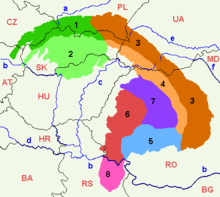Serbian Carpathians

Serbian Carpathians (
Definitions
Under the strict definition (as defined by the
However, in Serbian geography, the epithet "Carpathian" is traditionally also given to the whole northern part of the Carpatho-Balkan arc, which connects the Carpathians proper with the Balkan Mountains. It refers to the following mountains:[1]

- Šomrda
- Liškovac
- Veliki Greben
- Miroč
- Homolje Mountains
- Veliki Krš
- Mali Krš
- Stol
- Deli Jovan
- Beljanica
- Kučaj Mountains
- Rtanj
- Tupižnica
- Devica
- Ozren
There are incentives to incorporate the whole wider Serbian Carpathian region into the framework of the
Geology
The entire part of Serbia east of the
Though those mountains are related to the Carpathians from the geological point of view, they have been included to them by the scientists only at the end of the 20th century. In the past, those mountains were included by mistake to the
Demographics
Eastern Serbia is one of the most sparsely populated areas of the Balkans. A large portion of the population is engaged in nomadic sheep-breeding. The population is mixed of Serbs and Romanians. It is underdeveloped, with sparse infrastructure and long distances between towns.[4] The region is subject to further depopulation: between censuses of 1991 and 2002, municipalities of Bor and Majdanpek lost 3,500 residents each, Negotin lost 5,500, Zaječar lost 5,000, and Knjaževac 6,500.[5]
See also
References
- ^ a b c Upitnik za procenu nacionalne politike, legalnih i i institucionalnih okvira koji se odnose na Karpatsku konvenciju (PDF) (in Serbian), EURAC, 2006-09-11, retrieved 2010-08-27[permanent dead link]
- ^ Zakon o potvrđivanju Okvirne konvencije o zaštiti i održivom razvoju Karpata, National Assembly of Serbia, archived from the original on 2010-08-03
- ^ Milena Zlokolica-Mandić, Structural-Tectonic Elements as a Factor in Cave Development, SANU, archived from the original on 2011-07-27, retrieved 2010-11-03
- ^ Lazarev kanjon, National Geographic serbia, 2007-08-01, archived from the original on 2008-03-15
- ^ Branislav Radivojša (2002-08-01), Naselja U Srbiji - Rezultati Popisa (2), Politika
